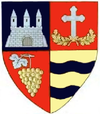Pecica
Pecica
Pécska | |
|---|---|
 The urban ensemble | |
 Coat of arms | |
 Location in Arad County | |
 Pecica Location in Romania | |
| Coordinates: 46°10′12″N 21°4′12″E / 46.17000°N 21.07000°ECoordinates: 46°10′12″N 21°4′12″E / 46.17000°N 21.07000°E | |
| Country | Romania |
| County | Arad |
| Government | |
| • Mayor (2020–2024) | Petru Antal[1] (PNL) |
| Area | 237.17 km2 (91.57 sq mi) |
| Population (2011)[2] | 12,762 |
| • Density | 54/km2 (140/sq mi) |
| Time zone | EET/EEST (UTC+2/+3) |
| Vehicle reg. | AR |
| Website | http://www.pecica.ro/ |
Pecica (Romanian pronunciation: [ˈpet͡ʃʲ.ka]; Hungarian: Pécska; German: Petschka; Serbian: Печка/Pečka) is a town in Arad County, Romania. In ancient times it was a Dacian fortress called Ziridava and today it is an important archeological site.[3][4] Situated at 25 kilometres (16 mi) from Arad, it was declared a town in 2004. Its administrative territory extends into the Arad Plateau. The town administers three villages: Bodrogu Vechi (Óbodrog), Sederhat (Szederhát) and Turnu (Tornya).
Population[]
| Year | Pop. | ±% |
|---|---|---|
| 2002 | 13,024 | — |
| 2011 | 11,885 | −8.7% |
| Source: Census data | ||
According to the census of 2011 the population of the town counts 12,762 inhabitants. The ethnic composition is as follows: 62.2% Romanians, 28% Hungarians, 8.4% Roma, 0.33% Slovaks, 0.36% Serbs and 0.7% are of other or undeclared nationalities.
History[]
Due to the abundance of archaeological finds of the zone an important historic period known as the Periam-Pecica culture was named after the settlement. The history of the localities Pecica, Bodrogu Vechi, Sederhat and Turnu is closely connected with the events making highly memorable the entire zone of the Arad Plateau.

The first mention in documents of the locality dates back to 1335 when it was known as Petk. Sederhat was registered only in 1913, Turnu in 1333 under the name of Mok, while Bodrogu Vechi in 1422 under the name of Bodruch. It has a complex political history with periods of Ottoman rule, periods of Habsburg Monarchy, Kingdom of Hungary and Kingdom of Romania. After the Austro-Hungarian Compromise of 1867, it became part of the Kingdom of Hungary within Austria-Hungary up until the Treaty of Trianon. Since then the town has been part of Romania.
Economy[]
Although the economy of the town is prevalent agricultural, the secondary and tertiary economic sectors have also developed recently. Besides agriculture, the industry of petrol and rock-gas is also well represented. The initiation of the frontier crossing point at Turnu and the trimming of the thermal water springs should be the most important chances for the economic development of the town.
Tourism[]
Tourist attractions include the Roman Catholic Church, the Pecica Cultural Center and the "Lunca Mureșului" park.
Notable residents[]
- Kuno von Klebelsberg (1875 – 1932), Hungarian politician, minister of interior and minister of culture
- Roman Ciorogariu (1852 - 1936), Romanian Romanian Orthodox bishop, journalist and educator
- Marius Cihărean (born 1975), Romanian weightlifter
- Mircea Petescu (born 1942), Romanian footballer and coach
Sister cities[]
See also[]
- Ziridava
- Pecica culture
References[]
- ^ "Results of the 2020 local elections". Central Electoral Bureau. Retrieved 8 June 2021.
- ^ "Populaţia stabilă pe judeţe, municipii, oraşe şi localităti componenete la RPL_2011" (in Romanian). National Institute of Statistics. Retrieved 4 February 2014.
- ^ Ember, Melvin; Peregrine, Peter Neal, eds. (2001). "Encyclopedia of Prehistory: Volume 1: Africa". Encyclopedia of Prehistory. 4 : Europe. Springer. p. 214. ISBN 0-306-46255-9.
- ^ Barbara Ann Kipfer, Encyclopedic Dictionary of Archaeology, p.428. Springer, 2000, ISBN 0-306-46158-7
External links[]
| Wikimedia Commons has media related to Pecica. |
- Populated places in Arad County
- Towns in Romania
- Archaeological sites in Romania
- Hungary–Romania border crossings
- Localities in Crișana

